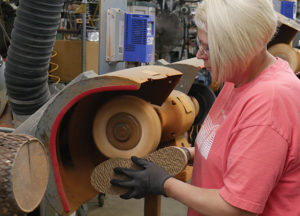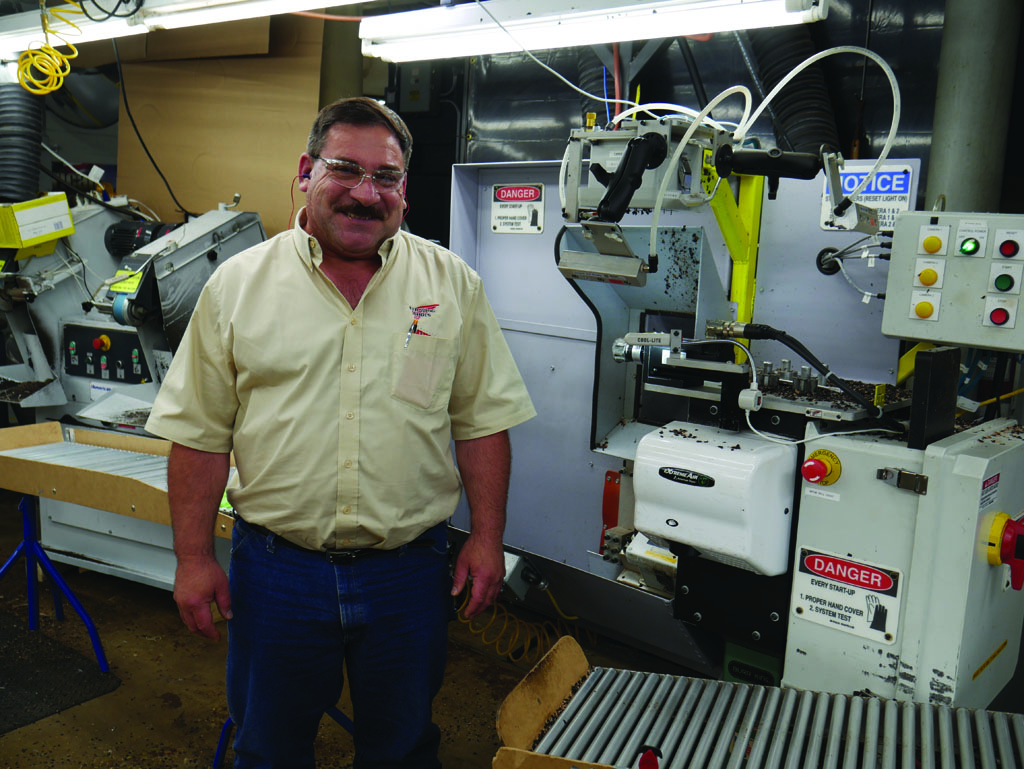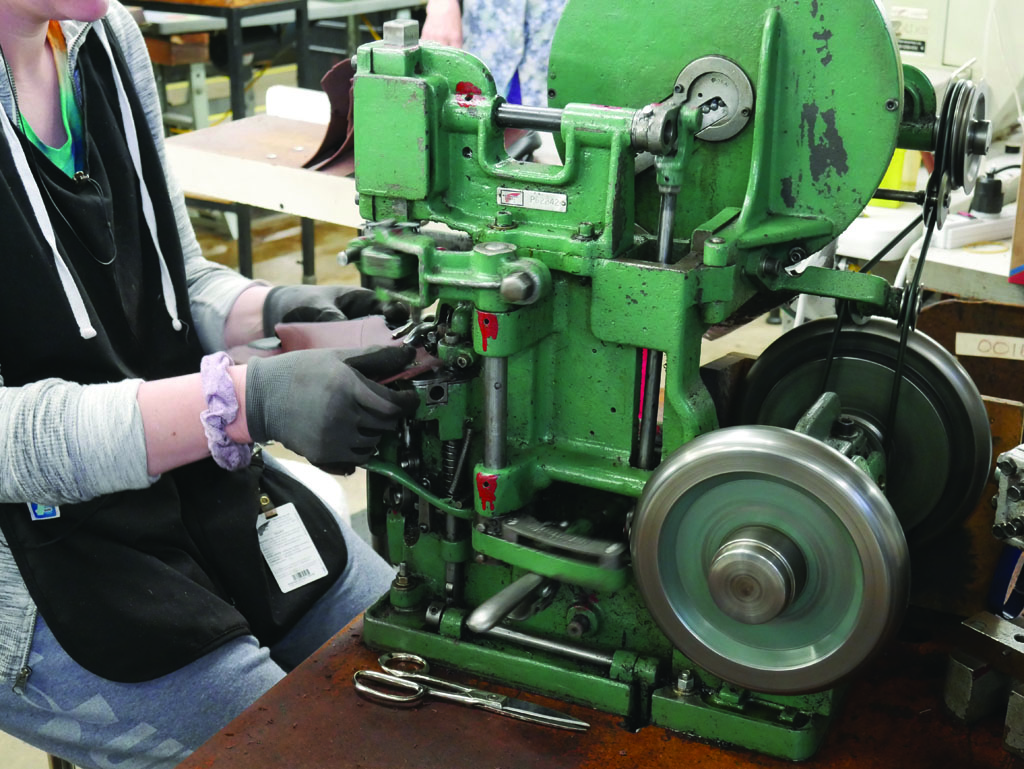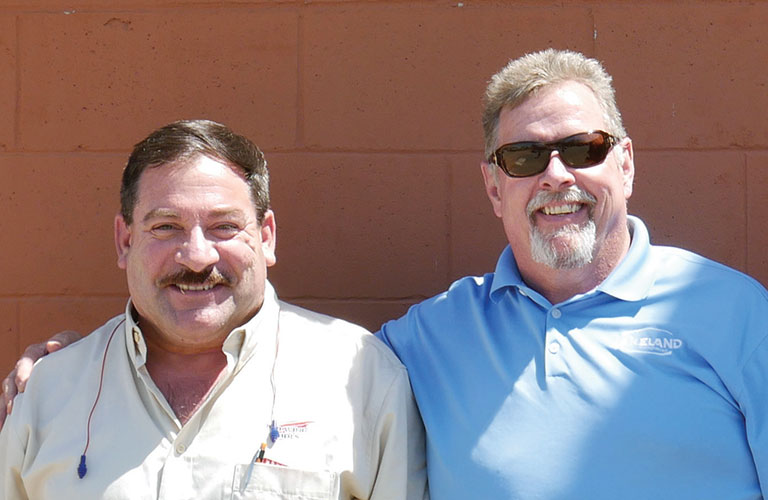Case Study – Red Wing Shoe Company Standardizes on Lenze VFD
Lakeland Engineering Equipment Company Collaborates with Lenze and Red Wing Shoe Company to Standardize on a Variable Frequency Drive Solution throughout their Manufacturing Plant
LAKELAND SUPPLIES LENZE SMV DRIVE TO RED WING SHOE COMPANY TO ENHANCE SAFETY, LIMIT TORQUE AND PROVIDE MORE USER-FRIENDLY PROGRAMMING
OVERVIEW
Red Wing Shoe Company was searching for a variable frequency drive (VFD) that would be adaptable enough to standardize on throughout their entire manufacturing floor. The VFD needed to be user-friendly and easy to program. Most importantly, their machines required a VFD that provided torque capabilities that would in-turn enhance operator safety.
Lakeland Engineering Equipment Company collaborated with Tim Schneider, Mechanical Design Engineering Specialist and Lakeland’s Lenze representative to select the Lenze SMV Drive and correctly wire and program the drive to meet the needs of Red Wing Shoe Company’s manufacturing process.

GOALS
- Standardize on one VFD throughout the manufacturing facility
- Enhance operator safety
- Control the torque parameters
- Easy to learn and use programming
- Lower costs with no loss of capabilities
- High performance and flexibility
- Eliminate downtime by stocking one part number
OUTCOME
Lakeland Engineering Equipment Company and Lenze supported Red Wing Shoe Company in their need for an electrical component solution that included a high performance VFD to control torque and increase safety. Lakeland and Lenze helped Red Wing Shoe Company wire, program and troubleshoot to find the correct solution that met all of their goals.
Red Wing Shoe Company then designed and built a hooker machine in-house that included this drive and other electrical components supplied by Lakeland. Since the fruition of these projects, Red Wing Shoe Company, Lakeland and Lenze have collaborated on other projects to standardize their plant with a single VFD solution, the Lenze SMV Drive.
THE STORY
Red Wing Shoe Company is dedicated to providing a safe working environment for their employees and this is one of the areas that Tim Schneider, Mechanical Design Engineering Specialist with Red Wing Shoe Company assists with. “I design machines from the ground-up, collaborate with our safety director and work to improve overall plant efficiency – amongst a variety of other things.”
Red Wing Shoe Company began working with Lakeland as a means to find a new drive that would provide torque control due to an injury that occurred on the buffer or brusher machine. This machine is one of the final stages of the shoe manufacturing process, it buffs and smooths the shoe prior to it going into final inspection stages.
FINDING A VARIABLE FREQUENCY DRIVE SOLUTION WITH LAKELAND

“We have a lot of these machines around the plant and knew something had to be done to increase the safety of our operators.”
“Our safety manager came to me one morning and told me about an injury that had occurred the previous night when the brusher had grabbed the shoe out of the employees hand and into the shroud which resulted in a cut,” said Tim. “We have a lot of these machines around the plant and knew something had to be done to increase the safety of our operators.”
Tim began working on a proposal for a new electrical component solution for the brusher machine that would allow torque control and parameters specific to their manufacturing process. “My synopsis included varying options and what the cost of these options would be,” said Tim. “The machines previously had a DC drive with little torque and high RPM from a different manufacturer.” The drive on the machine was not meeting the needs of Red Wing Shoe Company and was at a higher price tag. “I had worked with Lenze (AC Tech at the time) in my previous roles and knew that they would likely be the correct choice for a new VFD on the brushers.”
In addition to safety of personnel, one of Red Wing Shoe Company’s main goals with this project was to have a VFD that was very user-friendly and simple for maintenance personnel to program. While Tim was familiar with the capabilities that Lenze provided – he needed to select a distributor to provide the support of applying and wiring and programming the drives to meet the goals set-forth by Red Wing Shoe Company. Having worked with Lakeland in his previous position, he looked to them for assistance with this project.
WIRING AND PROGRAMMING THE LENZE SMV DRIVE FOR THE RED WING SHOE COMPANY BRUSHER MACHINES
One of the challenges Red Wing Shoe Company faced was the password protection sets on the Lenze SMV Drive. “I wanted to be able to change the parameters while the operators were working but still allow them to change the speed,” said Tim while explaining one of the challenges he ran into. “I called Lakeland and they worked with the Lenze representative and the factory to resolve this issue. They discovered that the password does not embed into the drive right away unless you cycle power. After this discovery, we had no issues accomplishing our goal.”
“We’re basically using the drive’s over-torque output as an internal input,” explained Tim while talking about the adaptability of the drive throughout their plant. “We don’t need to change the parameters from project to project, just the values. This flexibility is a huge benefit for us.”
This machine was Red Wing Shoe Company’s first introduction to adding the Lenze SMV Drives within their facility. The drive was also a lower cost solution that provided all of the capabilities they needed and more. Being pleased with the functionality and ease of programming, they looked to Lakeland for assistance on their next project – the hooker machine.
Lakeland has certified drives specialists and a team of expert resources that provide local support to customers. Lakeland brought in the Lenze representative to wire the drive and set the parameters applicable to Red Wing Shoe Company’s brusher machine. “The Lenze SMV drive has external inputs and outputs built-in to the drive to set the torque limit and have that be an output and feed that right back into the drive,” said Todd Spinner, Account Manager at Lakeland Engineering Equipment Company.“This can trigger the drive to stop, turn on a light, or perform a number of different commands depending on how the SMV drive is wired.”
Lakeland, Lenze and Red Wing Shoe Company worked together to outfit the brusher with an electrical component solution that met their requirements. “We did some trial and error to figure out how this would best work,” said Tim. “With the support we received from Lakeland and Lenze, we had the right solution by the third time they came to the plant.”

MACHINING PARTS TO BUILD A NEW HOOKER MACHINE INTERNALLY
The hooker machine was developed nearly a century ago, like many machines in the shoe making industry. A hooker machine is used to punch through and crimp the leather to place the hooks or eyelets that allow you to hook the lace to tie the shoe. At the time, there were a number of copy machines that were developed, each with slight differences. During this period, it was also not common to standardize on machines even if they were being built within the same facility – this has made finding the correct parts for the machines very difficult.
One of the many unique qualities of Red Wing Shoe Company is the amount of machinist work they do internally. Red Wing Shoe Company took apart a high functioning hooker machine, 3D scanned the parts of the machine, made a 3D model of the machine, and re-built the machine in-house to meet their goal of recording and stocking each part for this machine.
“You can’t take parts from machine A and put them on machine B,” said Tim. “Al Weberg, our Head Machinist, actually built parts for this machine. He is very talented.” This is one of the unique qualities and talents of Red Wing Shoe Company. Tim noted, “Everything we do here takes a team. I couldn’t do my job without each and every person in this company – everyone brings something new to the table.” Stocking one part for all of their machines would save parts, maintenance time and costs.

“Everything we do here takes a team. I couldn’t do my job without each and every person in this company – everyone brings something new to the table.”
CONTROLLING THE TORQUE AND INCREASING THE MACHINE SAFETY

The hooker machine required very similar electrical components as the brusher machine but it also required a gearbox and motor with low RPM that would work in tandem with the Lenze VFD and meet their functionality, safety and programming needs. Being pleased with the level of support received from Lakeland on the brusher machine, the capabilities of the drive, the cost of the drive, and the ease of use, Tim and his team again looked to Lakeland to supply these products and support. When asked why Lakeland, Tim replied, “The delivery and support – we never wait.”
“One of the issues where your drive has really saved the day are the torque capabilities,” said Tim. “Now I can vary how much torque I put out. Without any adjustment, it was either wide open or shut-off. This drive enables us to get the torque to where we want it. This allows us to save parts, money and everything that goes along with that.”
Lakeland and Lenze ensured that the drive was wired and programmed properly to the hooker machine prior to standardizing on this drive for the remainder of the machines within the plant. “Our operators liked and knew how to use the drives, which made Lenze an easy choice,” explained Tim. “We worked together to continue to fulfill our goal of standardizing on one drive throughout the plant.”
The rotary punch press requires enough inertia to punch through the leather. “Every piece of leather is different – from animal to animal,” said Tim. “Years ago you would punch through two layers of leather. Now, they could have three or four layers of leather – and every leather differs not only in its thickness but also in its density.”
“Prior to the introduction of these drives, when a machine stalled due to it not being able to punch through the leather, they would add a larger motor on the machine,” explained Tim. “This caused major issues as the machine then started to destroy parts within it.” This resulted in safety hazards and unnecessary machinist and operator hours.
“The motor on this machine had an open pulley and belt with a jack pulley off of that to drive the hopper and feed the hooks,” said Tim. “We didn’t want any exposed belts as employees hand-feed the shoe through the hooker machine for the anvil to punch down, and this caused safety concerns.” Tim paused there to note, “Their work is amazing – how they get the spacing right every time. The lion’s share of our work is done by hand, which really sets us and the quality of Red Wing Shoe Company apart from other manufacturers.”
Red Wing Shoe Company required a higher level of safety on the new machine they were building internally.

LAKELAND SUPPLIES ELECTRICAL COMPONENTS FOR ADDITIONAL RED WING SHOE COMPANY MACHINES
In addition to the above projects, Lakeland and Red Wing Shoe Company also collaborated on the electrical control system for the Edge Trimmer, a patented design by Tim Schneider and others. Lakeland worked with Tim to find the right solution for a power supply, connectors and cables.
Tim designed the machine with safety at the top of the list. The operator wears a certain color of glove when operating this machine. If the sensor on the machine sees the operators hands are within a certain distance, measured by the sensor, the machine is triggered to stop. Tim humbly stated that, “Every project I’ve ever had success with is due to the entire team behind it. It takes all of us to be successful.” Tim worked with PFM Integrators and his internal team to bring his patented design to fruition.

ENHANCED SAFETY, DECREASED COSTS AND OPERATOR EASE
The projects Lakeland and their team of resources have collaborated on to supply Red Wing Shoe Company with the electrical component solutions they need don’t stop there. The Lenze VFD is also used on the machine that adds curvature to the heel of the shoe or boot within the plant. “Being able to control torque saves money and time on parts and repairs,” said Tim. The drive is also used on a number of conveyors throughout the plant.
“The benefits of standardizing on the drive throughout the plant are endless,” said Tim. “Lakeland and Lenze helped meet all of our goals. Not only that but the Lenze drive has all of the parameters we needed and more. We were able to save a lot of development time with the ease of programming.” Adding the drive across much of manufacturing floor meant operators only had to learn the simple programming for this drive versus a different program for each machine.
“Being able to limit the torque was the biggest advantage for us given our safety needs and requirements,” said Tim. “We’ve had zero issues. I won’t buy anything else, why would I? The price is right, the functionality is right and we’re familiar with the drives and their capabilities.”

THE RED WING SHOE DIFFERENCE

Established in 1905 in Red Wing, MN, Red Wing Shoe Company has held true to the foundation with which it was built on, “a new standard for excellence.” Their shoes are built with premium leather from their own tannery, S.B. Foot Tannery.
Red Wing Shoe Company manufacturers about 5,000 pair of shoes per day in their Red Wing MN facility. Each pair is made by true craftsman, with much of the process being done by hand. To learn more about the factory and the skill, care and technique that goes into each pair of shoes, watch the Red Wing Shoe Company video, “The Factory.”
“They have always been a staple in the community,” Tim shared. “They do a lot for our community from scholarships to Habitat for Humanity and much more. They are very community driven which is hard to come by now. I also really appreciate the latitude I get here.”
WHAT’S NEXT FOR RED WING SHOE COMPANY AND LAKELAND?
Lakeland and Red Wing Shoe Company are currently working on standardizing their other manufacturing facility with the Lenze SMV Drive. Along with this, Tim’s next project is already in the works. Showing his impressive drawings and designs, Tim has developed a machine that will be used on the toe of the shoe that involves a clamp and electrical components such as specific sensors to measure distance. Like the other projects Tim has worked on, it is sure to be an innovative design that meets a need for enhancing efficiency, safety or both within their manufacturing plant.
